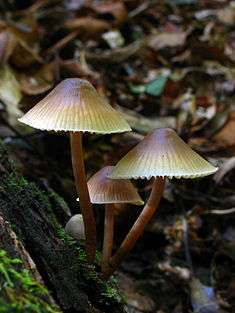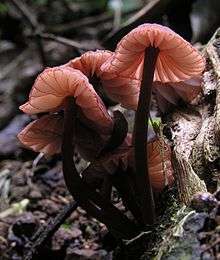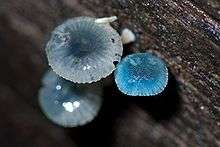Mycena
| Mycena | |
|---|---|
 | |
| Mycena galericulata | |
| Scientific classification | |
| Kingdom: | Fungi |
| Division: | Basidiomycota |
| Class: | Agaricomycetes |
| Order: | Agaricales |
| Family: | Mycenaceae |
| Genus: | Mycena (Pers.) Roussel (1806) |
| Type species | |
| Mycena galericulata (Scop.) Gray (1821) | |
| Species | |
|
| |
| Mycena sp. | |
|---|---|
|
| |
| gills on hymenium | |
| cap is conical | |
| hymenium is adnate | |
| stipe is bare | |
| spore print is white | |
| ecology is saprotrophic | |


Mycena is a large genus of small saprotrophic mushrooms that are rarely more than a few centimeters in width. They are characterized by a white spore print, a small conical or bell-shaped cap, and a thin fragile stem. Most are gray or brown, but a few species have brighter colors. Most have a translucent and striate cap, which rarely has an incurved margin. The gills are attached and usually have cystidia. Some species, like Mycena haematopus, exude a latex when the stem is broken, and many have the odor of bleach.
Mycenas are hard to identify to species and some are distinguishable only by microscopic features such as the shape of the cystidia. Some species are edible, while others contain toxins, but the edibility of most is not known, as they are too small to be useful in cooking. Mycena cyanorrhiza stains blue and contains the hallucinogen psilocybin[1] and Mycena pura contains the mycotoxin muscarine.
Over 33 species are known to be bioluminescent,[2][3] creating a glow known as foxfire. These species are divided among 16 lineages, leading to evolutionary uncertainty in whether the luminescence developed once and was lost among many species, or evolved in parallel by several species. What, if any, benefit the fungus derives from the luminescence is uncertain.
Alexander Smith's 1947 Mycena monograph identified 232 species; the genus is now known to include about 500 species worldwide.[4] Maas Geesteranus divided the genus into 38 sections in 1992, providing keys to each for all the species of the Northern Hemisphere. Many new species have been discovered since then, and four new sections have been proposed. Taxonomy is complex, as most sections are not truly homogeneous, and the keys fail for some species, especially those that satisfy some criteria for only part of their life cycle. Some sections contain only one species.
The name Mycena comes from the Ancient Greek μύκης, meaning mushroom.[5] Species in the genus Mycena (and in Hemimycena) are commonly known as bonnets.[6]
Selected species
- M. acicula
- M. adonis
- M. adscendens
- M. aetites
- M. albidocapillaris
- M. alphitophora
- M. atkinsonii
- M. atkinsoniana
- M. aurantiomarginata
- M. austrofilopes
- M. austrororida
- M. arcangeliana
- M. asterina (Bioluminescent)
- M. atrata
- M. brunneospinosa
- M. cahaya (Bioluminescent)[7]
- M. californiensis
- M. capillaripes
- M. chlorophos
- M. cinerella
- M. citricolor
- M. citrinomarginata
- M. clariviolacea
- M. crocata
- M. cyanorrhiza
- M. cystidiosa
- M. daisyogunensis
- M. discobasis (Bioluminescent)
- M. domingensis
- M. epipterygia
- M. erubescens
- M. fera (Bioluminescent)
- M. flavescens
- M. flavoalba
- M. fonticola
- M. fuhreri
- M. fuscoaurantiaca
- M. galericulata
- M. galopus
- M. griseoviridis
- M. guldeniana
- M. haematopus
- M. holoporphyra
- M. illuminans
- M. inclinata
- M. interrupta
- M. intersecta
- M. kentingensis (Bioluminescent)
- M. kuurkacea
- M. lacrimans
- M. leaiana
- M. lacrimans (Bioluminescent)
- M. lanuginosa
- M. leptocephala
- M. lucentipes (Bioluminescent)
- M. luteopallens
- M. luxaeterna (Bioluminescent)
- M. luxarboricola (Bioluminescent)
- M. maculata
- M. manipularis
- M. marasmielloides
- M. metata
- M. minirubra
- M. multiplicata
- M. mustea
- M. nargan
- M. nidificata
- M. noctilucens
- M. olida
- M. olivaceomarginata
- M. oregonensis
- M. overholtsii
- M. pelianthina
- M. polygramma
- M. pseudostylobates
- M. pura
- M. pura complex
- M. purpureofusca
- M. renati
- M. rorida
- M. rosea
- M. rosella
- M. sanguinolenta
- M. seminau (Bioluminescent)[7]
- M. semivestipes
- M. sinar (Bioluminescent)[7]
- M. singeri (Bioluminescent)
- M. spinosissima
- M. stipata
- M. strobilinoides
- M. stylobates
- M. subcaerulea
- M. sublucens
- M. tenuispinosa
- M. tintinnabulum
- M. urania
- M. vinacea
- M. viscosa
- M. vitilis
- M. vulgaris
- M. zephirus
See also
References
- ↑ Gaston Guzman, John W. Allen & Jochen Gartz, "A Worldwide Geographical Distribution of the Neurotropic Fungi, An Analysis And Discussion",Vol14(1998), 189–280, 2000.
- ↑ Desjardin DE, Perry BA, Lodge DJ, Stevani CV, Nagasawa E (2010). "Luminescent Mycena: new and noteworthy species". Mycologia. 102 (2): 459–77. doi:10.3852/09-197. PMID 20361513.
- ↑ Desjardin DE, Oliveira AG, Stevani CV (2008). "Fungi bioluminescence revisited". Photochemical & Photobiological sciences. 7 (2): 170–82. doi:10.1039/b713328f. PMID 18264584.
- ↑ National Geographic Photo in the News article
- ↑ Rea, Carleton (1922). British Basidiomycetaceae: a Handbook to the Larger British Fungi. Cambridge, UK: Cambridge University Press. p. 373.
- ↑ "Recommended English Names for Fungi in the UK" (PDF). British Mycological Society.
- 1 2 3 Chew AL, Tan YS, Desjardin DE, Musa MY, Sabaratnam V (2014). "Four new bioluminescent taxa of Mycena sect. Calodontes from Peninsular Malaysia". Mycologia. 106 (5): 976–88. doi:10.3852/13-274. PMID 24891424.
Further reading
- Smith, Alexander Hancett. North American Species of Mycena. Ann Arbor: Univ. of Michigan Press, 1947.
External links
| Wikimedia Commons has media related to Mycena. |
| Wikispecies has information related to: Mycena |
- Mushroom Expert - The Genus Mycena
- Key to the Mycenoid Species in the Pacific Northwest
- Fungi Bioluminescence Laboratory
- Online copy of Smith's 1947 Monograph from the University of Michigan Herbarium
- National Geographic Photo in the News, featuring pictures of bioluminescent species
- Keys for Mycena species found in Norway, including a great deal of information on many species